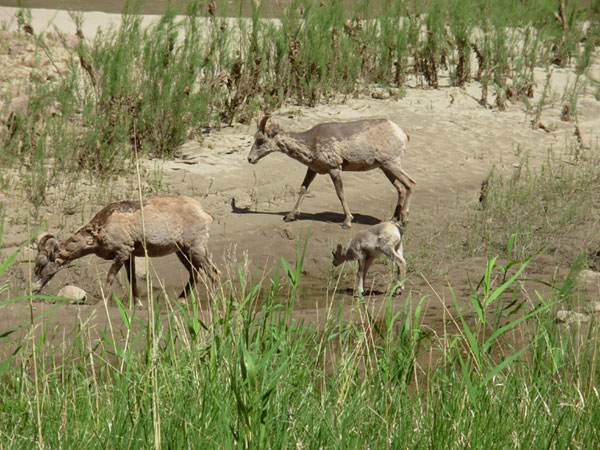Geomorphic Description
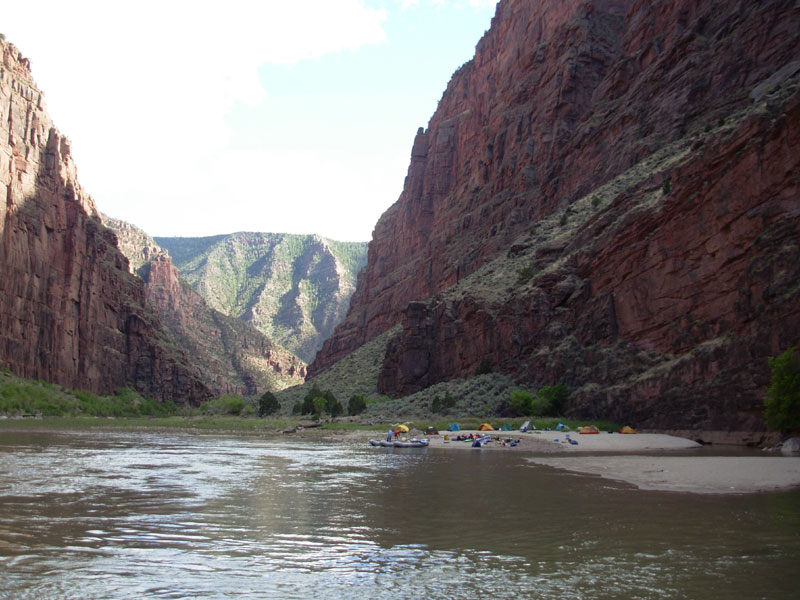
Approximately 3 miles downstream from the Gates of Lodore, a channel constriction between two opposing debris fans creates a fan-eddy complex immediately downstream from Winnie’s Rapid. Pre-dam flood flows were able to mobilize coarse-grained debris fan materials and deposit them at the bottom of the downstream eddy, creating an abnormally large expansion/eddy bar. While annual post-dam flood flows inundate this surface, substrate mobilization appears minimal. Active geomorphic surfaces include eddy sandbars comprised of both separation and reattachment bars, surfaces which are likely highly mobile during post-dam flood events. This sediment mobilization allows for the creation of substantial backwater habitat between the eddy bar and western bedrock canyon wall. Flow regulation has created distinctive geomorphic surfaces and vegetation assemblages along the southern edge of the fan eddy complex. The active floodplain on the downstream eddy/expansion bar is entirely occupied by juvenile tamarisk. The adjacent intermediate bench is colonized by a variety of grasses, while the pre-dam floodplain (C-B terrace) is primarily occupied by box elders and junipers.

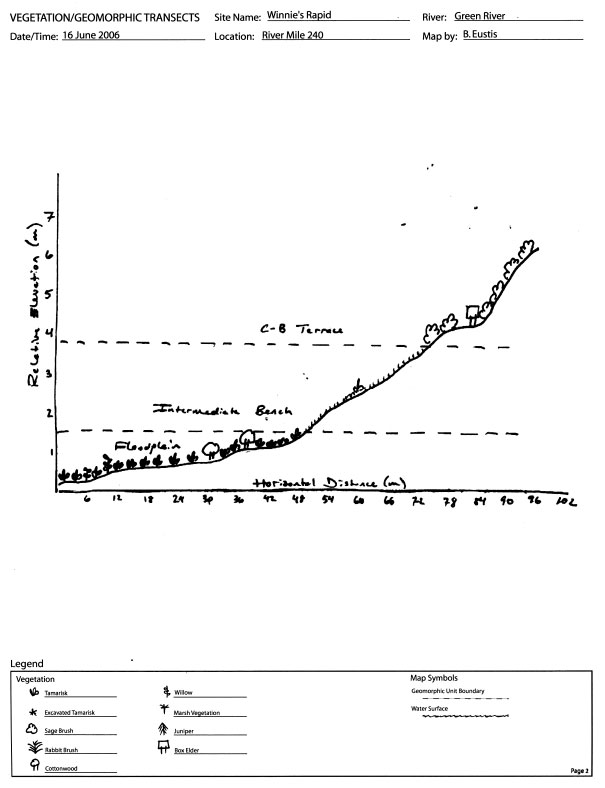
RIPARIAN VEGETATION
Winnie’s Bar is a region that according to Dr. Jack Schmidt of the University of Utah, was excavated of all tamarisk around the year 2004. Our transect was located on the expansion bar downstream of a large debris-fan, ran perpendicular to the waters edge, and extended to the bedrock (see geomorphology map). The transect included the entire lateral width of the post-dam terrace, as well as the intermediate bench and the pre-dam terrace (see geomorphology cross-section). The post-dam terrace was densely vegetated with many similarly aged tamarisk recruits. Coarse and fine grained sediment was observed on the post-dam terrace. A few cottonwood recruits were also sampled here, but because no mature cottonwoods were ever seen in Lodore Canyon, it is presumed that the recruits have very little chance of survival. Several large pits were observed randomly within the post-dam terrace and the intermediate bench. These are most likely where mature tamarisks were dug up by their roots during excavation attempts. The intermediate bench was largely covered with grass and herbaceous plants. The only woody riparian plant observed on the intermediate bench was tamarisk. The pre-dam terrace primarily consisted of sagebrush and box elder. Utah junipers were also observed on this surface near the bedrock.
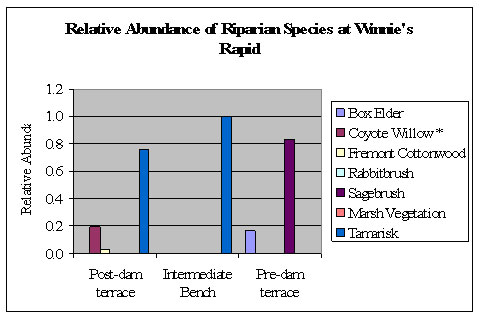
WATER QUALITY
This site demonstrates potential differences in rapids vs. backwater areas. The temperature is slightly lower in the fast moving rapids than the relatively stagnant backwaters. At low flows, the backwater would become partially disconnected from the main channel, becoming even more stagnant.

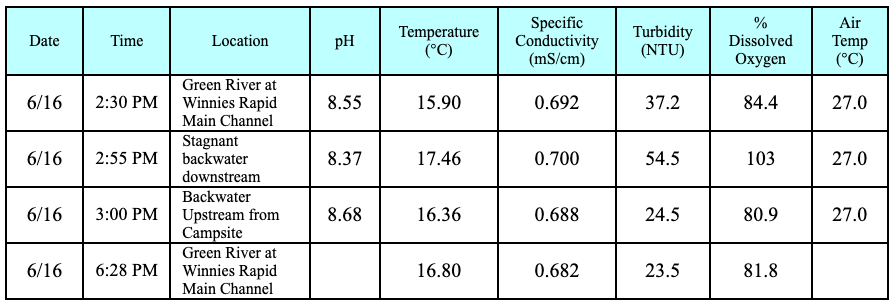
FISH
Seine Collection Data:
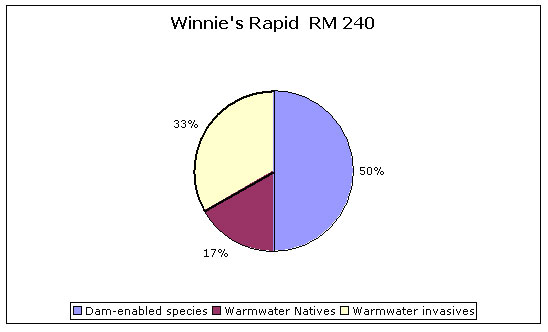

General Comments:
Angling was especially productive in the backwaters adjacent to the areas where we seined. Our efforts produced a variety of fishes in a back-eddy pool up against an undercut rock wall including: a channel catfish (375mm), a flannelmouth sucker (450mm), a rainbow trout (380mm), and several brown trout, the largest of which was 360mm. Gut analysis showed they were feeding on mormon crickets, which were extremely abundant in this area. The large rainbow trout had a stomach packed full of 12 cricket bodies. Seining was performed during daylight and nighttime hours. We observed higher yields during the nighttime seining sessions.
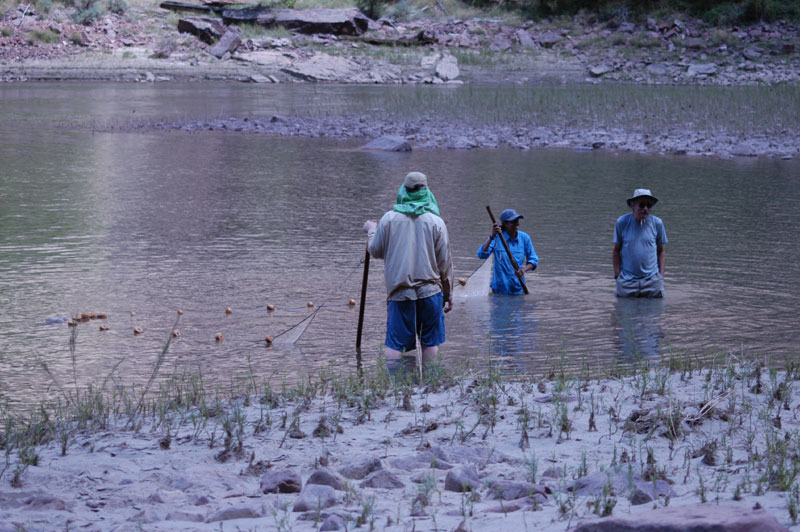
AQUATIC INVERTEBRATES
Sampling sites were selected in slow backwater habitat as well as riffle habitat. Substrate size and aquatic vegetation cover were estimated.
Habitat A - Slow flow, backwater vegetation bed
Substrate: 30% silt, 70% sand
Vegetation: Elodea, Potamogeton crispus (curly pondweed)
Diversity: 1.93
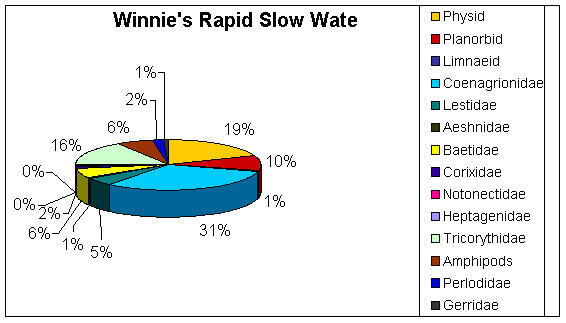
Habitat B - Substrate: 20% cobble, 80% boulder
Vegetation: ~65% cover, mostly Cladophora, some Chara and bryophyte
Diversity: 1.44
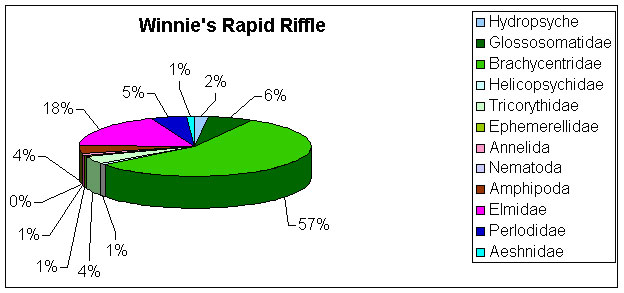
Comments: The relatively small and warm backwater at Winnie’s rapid was our most diverse site and also very rich in fish fauna. Adult perlodids were abundant and emerging (stonefly hatch) during our sampling period.
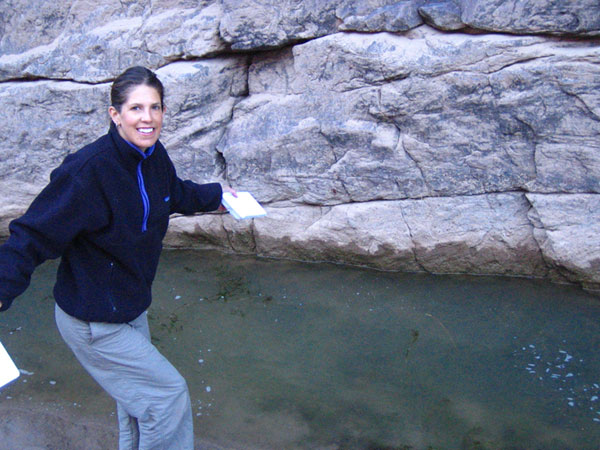

BIRDS, MAMMALS, REPTILES, AND AMPHIBIANS
We surveyed this site for an hour in the mid-afternoon. There was a gentle breeze and between 25 to 50% cloud cover. This site, within the Canyon of Lodore, consisted of a sandbar with surrounding vegetation: colonizing shrubs, tamarisk, and large junipers. All species were identified by visual sightings.
The rocky canyon slopes at this survey site provided ideal habitat for lizards and rock wrens. Three bighorn sheep were present at the site, and we observed several more bighorns on the edge of the river as we approached our site earlier in the afternoon (Fig. 6). Over the night, we left a bit of grain in a muddy area so as to collect tracks of small mammals who came to consume the grain, but it was left untouched in the morning. Few small mammal species use this canyon habitat, demonstrated by the lack of visual encounters and track identification. Bats, however, diurnally occupy caves within the canyon, leaving at night to forage elsewhere.
|
Common Name |
Scientific Name |
# |
ID |
Location |
|
Black-throated gray warbler |
Dendroica nigrescens |
2 |
sight |
junipers |
|
Rock wren |
Salpinctes obsoletus |
5 |
sight |
rocks |
|
Turkey vulture |
Cathartes aura |
3 |
sight |
air |
|
Bighorn sheep |
Ovis canadensis |
3 |
sight |
rocks |
|
Sagebrush lizard |
Sceloporous graciosus |
1 |
sight |
rocks |
|
Side-blotched lizard |
Uta stansburiana |
1 |
sight |
rocks |
